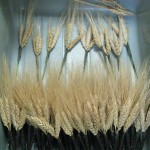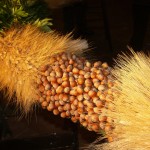Above, from left to right: ears of wheat wired to florist’s picks; two segments of wheat ears flank a segment of hazelnuts; preparing to hang the wreath in the Romanesque Hall. Photographs by Barbara Bell.
The wreath now on display high on the west wall of the Romanesque Hall above the thirteenth-century limestone doorway from Moutiers-St. Jean was designed and installed for the first time last December. The design is based on that of a wreath motif in a fragment of a fifteenth-century wall hanging in the Museum???s collection, in which four festoons of fruits, leaves, and flowers are bound together with ribbon to form a circle.
In our version, the festoons are composed of hazelnuts, wheat ears, and bay leaves, bound together with red cord. All the elements have been chosen with a view to both their association with the medieval celebration of Christmastide and their practicality and durability. Unlike the arches in the Main Hall (see previous post), which can be refreshed once a week, replacing apples and ivy leaves as necessary, the wreath cannot be reached once it has been hung. Both the hazelnuts and the wheat are dry materials that remain stable. The bay leaves are fresh when the wreath is made, but they dry well and remain attractive for the six weeks that the wreath is on display.
The form for the wreath is made of wood padded with straw.?? All the elements are wired to wooden florist???s picks, which are then firmly inserted into the base. The wreath holds up well under the handling necessary to carry it across the Museum courtyard from the workshop where it is made, through the Main Hall, and into the Romanesque Hall, where it is raised and hung from the wall. However, it must be made anew each year.
Festal wreaths and crowns were important civic and artistic symbols in classical culture. While the early Fathers of the Church objected to the use of such pagan emblems,??these symbols eventually acquired??a Christian significance and were used to celebrate the feast days of the Church calendar. Bay laurel, associated in antiquity with victory, became a symbol of the triumph of Christ and of eternal life.
The true bay laurel (Laurus nobilis) is an evergreen plant native to the Mediterranean still much used as a festal green in Europe, as it has been for many centuries. Because fresh stems of bay laurel are not commercially available in this country, we substitute the closely related California bay (Umbellularia californica), which is widely used for making holiday wreaths and garlands in the U. S.
Wheat??is an appropriate element, not only because it is beautiful and durable, but also because of its symbolic association with life and renewal???an ancient symbolism that was incorporated in Christian liturgy and iconography. In Nativity scenes of the fourteenth and fifteenth centuries, a sheaf of wheat is often shown near the crib in which the Christ Child lies; sometimes the infant Jesus rest on a heap of wheat in allusion to the bread of the Mass.
Wheat???s old associations with the promise of fertility and increase in the coming year were also preserved, and folk rites and practices involving gravitated to the Christmas season. The celebration of the New Year included ceremonies in which a sheaf of wheat kept from the harvest was used to make frumenty, a special dish of spiced and sweetened wheat berries boiled in milk. Sheaves of grain were also kept to provide a special meal for sheep and cattle. Tommaso da Celano, the biographer of Francis of Assisi, records that the saint urged town dwellers to spread grain on the streets so that the birds too might share in the Christmas feast.
???Deirdre Larkin
Tags: bay, bread wheat, laurel, Laurus nobilis, Triticum aestivum, Triticum durum, Umbellularia californica




December 11, 2008 at 12:43 am
thanks for all the detailed information. I’d love to keep to a medieval theme at home and your authentic details are quite helpful. thanks!! I love this site.
December 16, 2008 at 10:55 am
Dear Thea,
The next post will be on holly, the most significant of the plants associated with the medieval celebration of Christmastide, and the most beautiful. Unfortunately, holly does not tolerate dry or overheated atmospheres very well, and if it is used indoors should be kept in water. It lasts much longer outdoors, but is not suitable in very cold climates, as the berries will turn black. I have used it on the exterior of the Museum when the temperatures were down in the twenties without adverse effects.